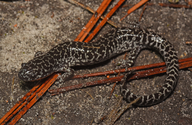|
Ambystoma bishopi Goin, 1950
Reticulated Flatwoods Salamander Subgenus: Linguaelapsus | family: Ambystomatidae genus: Ambystoma |
| Species Description: Goin, C. J. (1950). A study of the salamander, Ambystoma cingulatum, with the description of a new subspecies. Annals of the Carnegie Museum. Pittsburgh 31, 299–321. | |
|
Taxonomic Notes: Elevated to full species by: Pauly GB, Piskurek O, Shaffer HB (2006). Phylogeographic concordance in the southeastern United States: the flatwoods salamander, Ambystoma cingulatum, as a test case. Mol. Ecol. 16:415-429. |
|
 © 2023 Kevin G. Hutcheson (1 of 13) |
|
|
Author: Jean Raffaëlli
Ambystoma (Linguaelapsus) bishopi Goin, 1950
Ressemble beaucoup à A. cingulatum, avec lequel il était confondu jusqu'à sa restauration par Pauly et al. en 2006. Dessin réticulé comme chez A. cingulatum mais les réticulations sont gris brunâtre et moins prononcées. Cette espèce est également légèrement plus petite, possède une tête plus fine et des membres moins allongés. * Forêts de pins et savanes de la plaine côtière du Golfe du Mexique depuis la région de la Baie de Mobile (sud Alabama) jusqu'à l'ouest immédiat de la rivière Apalachicola, qui marque la frontière avec l'aire d'A. cingulatum. A. bishopi est en voie de raréfaction, bien que son statut conservatoire soit moins dramatique que celui de l'espèce précédente (20 populations encore présentes, selon Pauly et al., 2012). Gorman et al., (2009) ont conduit en Floride, dans la zone de distribution d' A. bishopi, une étude fine sur les causes de la raréfaction de cette espèce et de cingulatum, montrant que la suppression des feux traditionnels de broussaille dans la région a favorisé l'installation de la végétation (Pinus palustris) qui a pour conséquence un accroissement de l'évapotranspiration. Les feux favorisaient aussi le développement de graminées, dont Aristida stricta, qui formaient un couvert végétal favorable aux larves et aux jeunes, ainsi qu'à la ponte des femelles dans les brindilles. EN.
 ENGLISH TRANSLATION - Krystal Austin,
April 2017 ENGLISH TRANSLATION - Krystal Austin,
April 2017
Ambystoma (Linguaelapsus) bishopi Goin, 1950
Closely resembles A. cingulatum, with which it was confused up until Pauly et al. distinguished between the two species in 2006. This species has a reticulated pattern like A, cingulatum but the reticulations are gray-brown and less pronounced. This species is also slightly smaller, has a thinner head and shorter limbs. A. bishopi can be found in the pine forests and savanas of the costal plains of the Gulf of
Mexico, from Mobile Bay (south Alabama) to the immediate west of the Apalachicola River, that marks
the boundary with A. cingulatum’s territory. A. bishopi is becoming increasingly rare, even
though its conservation status is less dramatically alarming than A. cingulatum’s, (20 populations
are still present according to Pauly et al., 2012). Gorman et al., (2009) conducted a
detailed study on the causes of decline in this species and in cingulatum in A. bishopi’s
zone of distribution in Florida, showing that the traditional suppression of brush fires in the region has
favored the growth of Pinus palustris vegetation which increases the amount of
evapotranspiration. Normal brush fires favor the development of grasses, like Astrida stricta,
that form a vegetal covering that is favorable to the larvae and young, as well as female egg-laying in
the twigs. Vulnerable (VU).
Feedback or comments about this page.
Citation: AmphibiaWeb. 2025. <https://amphibiaweb.org> University of California, Berkeley, CA, USA. Accessed 1 Apr 2025. AmphibiaWeb's policy on data use. |



 Raffaëlli Account
Raffaëlli Account Map of Life
Map of Life